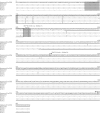Detection of Merkel cell polyomavirus with a tumour-specific signature in non-small cell lung cancer
- PMID: 23322199
- PMCID: PMC3593539
- DOI: 10.1038/bjc.2012.567
Detection of Merkel cell polyomavirus with a tumour-specific signature in non-small cell lung cancer
Abstract
Background: We searched for a viral aetiology for non-small cell lung cancer (NSCLC), focusing on Merkel cell polyomavirus (MCPyV).
Methods: We analysed 112 Japanese cases of NSCLC for the presence of the MCPyV genome and the expressions of RNA transcripts and MCPyV-encoded antigen. We also conducted the first analysis of the molecular features of MCPyV in lung cancers.
Results: PCR revealed that 9 out of 32 squamous cell carcinomas (SCCs), 9 out of 45 adenocarcinomas (ACs), 1 out of 32 large-cell carcinomas, and 1 out of 3 pleomorphic carcinomas were positive for MCPyV DNA. Some MCPyV DNA-positive cancers expressed large T antigen (LT) RNA transcripts. Immunohistochemistry showed that MCPyV LT antigen was expressed in the tumour cells. The viral integration sites were identified in one SCC and one AC. One had both episomal and integrated/truncated forms. The other carried an integrated MCPyV genome with frameshift mutations in the LT gene.
Conclusion: We have demonstrated the expression of a viral oncoprotein, the presence of integrated MCPyV, and a truncated LT gene with a preserved retinoblastoma tumour-suppressor protein-binding domain in NSCLCs. Although the viral prevalence was low, the tumour-specific molecular signatures support the possibility that MCPyV is partly associated with the pathogenesis of NSCLC in a subset of patients.
Figures




Comment in
-
Integrated and mutated forms of Merkel cell polyomavirus in non-small cell lung cancer.Br J Cancer. 2013 Jun 25;108(12):2624. doi: 10.1038/bjc.2013.196. Epub 2013 Jun 4. Br J Cancer. 2013. PMID: 23736033 Free PMC article. No abstract available.
-
Merkel cell polyomavirus and non-small cell lung cancer.Br J Cancer. 2013 Jun 25;108(12):2623. doi: 10.1038/bjc.2013.195. Epub 2013 Jun 4. Br J Cancer. 2013. PMID: 23736034 Free PMC article. No abstract available.
References
-
- Andres C, Ihrler S, Puchta U, Flaig MJ. Merkel cell polyomavirus is prevalent in a subset of small cell lung cancer: a study of 31 patients. Thorax. 2009;64:1007–1008. - PubMed
-
- Babakir-Mina M, Ciccozzi M, Lo Presti A, Greco F, Perno CF, Ciotti M. Identification of Merkel cell polyomavirus in the lower respiratory tract of Italian patients. J Med Virol. 2010;82:505–509. - PubMed
Publication types
MeSH terms
Substances
LinkOut - more resources
Full Text Sources
Other Literature Sources
Medical
Research Materials

